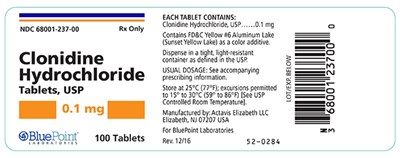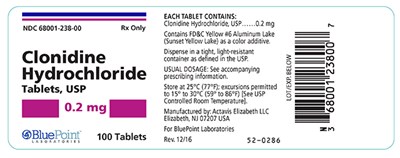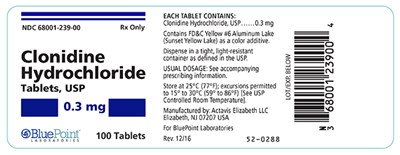Product Images Clonidine Hydrochloride
View Photos of Packaging, Labels & Appearance
Product Label Images
The following 7 images provide visual information about the product associated with Clonidine Hydrochloride NDC 68001-238 by Bluepoint Laboratories, such as packaging, labeling, and the appearance of the drug itself. This resource could be helpful for medical professionals, pharmacists, and patients seeking to verify medication information and ensure they have the correct product.
image 5

This is a description of Clonidine Hydrochloride Tablets, USP manufactured by Actavis Elizabeth LLC, and packaged by BluePoint Laboratories. Each tablet contains 0.1 mg of Clonidine Hydrochloride, USP, and a color additive, Yellow #6 Aluminum Lake. Dosage information is available in the accompanying prescribing information. Storage instructions recommend keeping the tablets at a controlled room temperature between 30°C (59°F) and 86°F as defined by the USP. The text includes a lot number, Noc ss001237.00, and a reference number, 52-0284.*
image 6

Clonidine Hydrochloride is a prescription drug contained in BluePoint tablets, with each tablet containing 0.2mg of Clonidine Hydrochloride, FDAC Yellow #6 Aluminum Lake (sunset yellow lake) 5.2 color, dispensed in a light-resistant container, as defined in the USP. Dosage information is not provided. The tablets must be stored at room temperature. Manufactured by Actavs Elizabeth LLC at Elizabeth, USA, and intended for Bluehoint Laboratories.*
image 7

Each tablet is composed of Clonidine Hydrochloride, USP of 0.3mg accompanied by a color additive Sunset Yellow Lake. The usual dosage is not mentioned. The tablets should be stored at a temperature of 25°C (77°F) and can be permitted at excursions. Temperature range of 15°C to 30°C (59°F to 86°F) is allowed as per USP standards. The text also includes a batch number and product name.*
* The product label images have been analyzed using a combination of traditional computing and machine learning techniques. It should be noted that the descriptions provided may not be entirely accurate as they are experimental in nature. Use the information in this page at your own discretion and risk.



